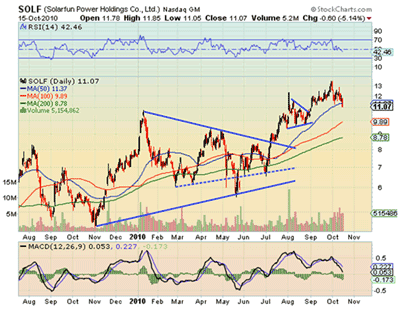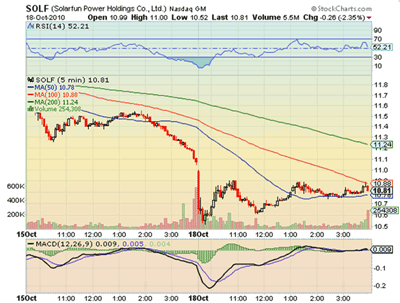The question often comes up with traders I talk with, “How do I decide to cut a losing position if I still think it has good upside?” The correct response is “You should never be in that situation.”
Avoiding it lies in selecting the proper stop loss level and then picking the right entry. Let me illustrate with a recent trading example. Here is a chart of Solarfun Power Holdings (SOLF) from my watch list going into trading last Monday. Looking at this chart, I had picked this as a short opportunity if it broke below the $11.00 support area from September 2, as it was already under a falling 50-day simple moving average (SMA), and set a target of $9.89, the 100-day SMA.
I chose a stop loss of $11.07, the Friday closing price. The stock already had some downward momentum, so even though it was a tight stop, it was significant in that it meant that the $11.00 support had been breached and then retaken, perhaps reversing the downside momentum if the stop were to be hit. This created a reward:risk ratio of 15.86 [(11.00-9.89)/.07], which is very high.
All that analysis assumed that I could get into the stock at near $11.00 early Monday. Now look at what happened at the open.
The stock opened at $10.99 and immediately traded down to $10.60 before I could get filled. Even though I still saw potential for a 71-cent downside move—an over-6.7% move in the stock price—this moved the reward:risk ratio down to 1.51, one tenth of the pre-market analysis. To enter this trade at $10.60 would leave you asking that question above.
There is too much downside risk in the trade back to the $11.07 stop. If I entered a short position at $10.60, I would be in that situation, when it quickly backed up to $10.90, down 30 cents on my trade, wondering if I should cut it or hang on. Waiting on a better reward:risk ratio or moving on to another opportunity is a better idea.
Find the opportunity, select the right stop loss, and pick the proper entry and you will not be scratching your head about how long you should stay in a loser or take profits on a winner.
By Greg Harmon of DragonflyCap.com



















